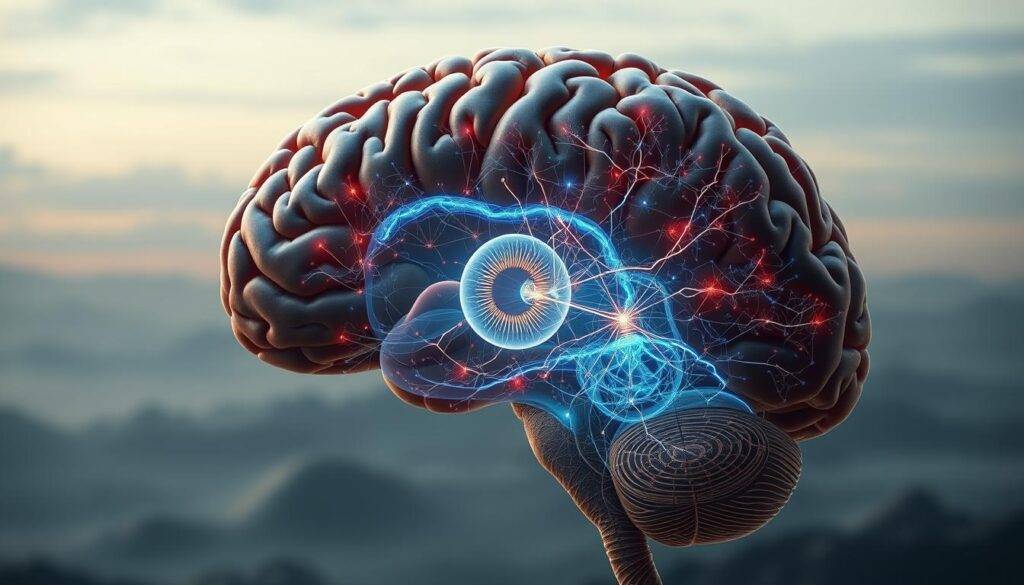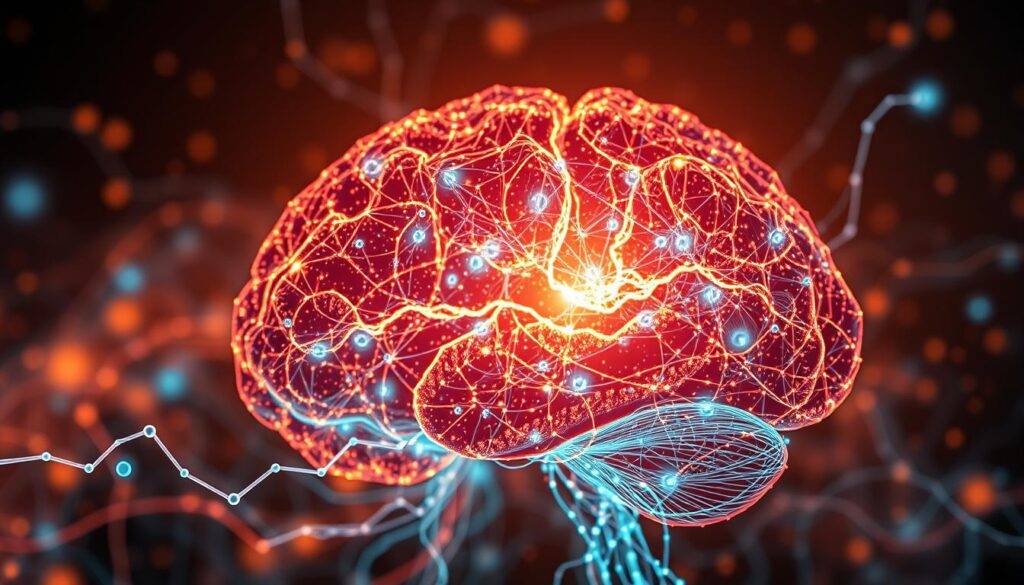Did you know that our subconscious mind plays a significant role in shaping our decisions and behaviors? Anchoring techniques have been used for centuries to influence perceptions and outcomes. By combining visualization with anchoring, individuals can create a powerful tool for subconscious change.
This dual method leverages the mind’s ability to create mental blueprints through visualization and lock in desired states using anchoring. The synergy between these techniques can lead to lasting transformation in various aspects of life.
The effectiveness of this approach lies in its ability to program the mind for success, making it a valuable tool for personal and professional development.
Key Takeaways
- Combining visualization and anchoring techniques can lead to subconscious change.
- These techniques work synergistically to program the mind for success.
- The dual method can be applied to various aspects of personal and professional development.
- Understanding the scientific basis behind these techniques is crucial for effective implementation.
- Practical application of these techniques can lead to lasting transformation.
Understanding Visualization and Anchoring: The Science Behind the Magic
To truly harness the power of visualization and anchoring, it’s essential to comprehend the underlying neurological processes. Visualization and anchoring are not just simple techniques; they are backed by complex psychological and neurological principles that, when understood, can significantly enhance their effectiveness.
The Neurological Basis of Visualization
Visualization involves the creation of mental images that stimulate the brain’s neural pathways, mimicking the effects of actual experiences. When you visualize, you’re not just seeing pictures in your mind; you’re activating the same neural networks that are involved in real-life experiences. This process can strengthen the connection between your mental state and your physical responses, making visualization a powerful tool for personal development and performance enhancement.
The brain’s ability to reorganize itself by forming new neural connections is known as neuroplasticity. Visualization leverages this ability, allowing individuals to rewire their brains and adopt new thought patterns and behaviors. By consistently visualizing specific outcomes or states, individuals can prime their minds and bodies for those experiences, enhancing their ability to achieve their goals.

Anchoring: Origins in Neuro-Linguistic Programming
Anchoring techniques have their roots in Neuro-Linguistic Programming (NLP), a psychological approach developed in the 1970s by Richard Bandler and John Grinder. NLP focuses on the connection between neurological processes, language, and behavioral patterns. Through NLP, anchoring was introduced as a method to associate specific stimuli with desired emotional states or responses.
Anchoring in NLP was inspired by Pavlovian conditioning but expanded to include the intentional creation of stimulus-response patterns for personal development. NLP practitioners discovered that anchors could be created for accessing resourceful mental and emotional states on demand. This technique has evolved from clinical applications to mainstream personal development and performance enhancement tools, with modern neuroscience validating many of the empirical observations made by early NLP practitioners about anchoring effects.
The practical applications of NLP-based anchoring are diverse, ranging from therapy and sports psychology to business leadership. By understanding the key NLP principles that underpin effective anchoring, such as submodalities, state management, and pattern interruption, individuals can harness the full potential of anchoring techniques to achieve their desired outcomes.
How Visualization Works in Your Brain
Visualization is a powerful tool that leverages the brain’s ability to create mental images, influencing both mind and body. This technique involves creating a vivid mental blueprint of a desired outcome, incorporating various sensory details such as colors, sounds, and textures. By regularly mentally rehearsing this visualization, individuals can anchor it to a specific physical gesture or object, enhancing its effectiveness.

The Mind-Body Connection During Visualization
During visualization, the mind and body interact in complex ways, activating similar neurological pathways as actual physical experience. This mind-body connection is crucial for understanding how visualization can lead to real-world changes. The brain processes mental imagery by engaging various regions, including those responsible for emotional regulation and motor control.
The cerebellum, for instance, plays a significant role in coordinating mental rehearsal, similar to how it coordinates physical movements. This neural activity can lead to improvements in skills and performance without actual physical practice, demonstrating the profound impact of visualization on both mental and physical states.
Creating Neural Pathways Through Mental Imagery
Mental imagery, a key component of visualization, contributes to the creation and strengthening of neural pathways in the brain. The concept “neurons that fire together, wire together” explains how repeated visualization can lead to long-term potentiation (LTP) between neurons, thereby strengthening synaptic connections related to the visualized activity.
Through consistent practice over time, visualization can optimize neural pathway development by factors such as vividness, perspective, and emotional engagement. This process enhances the brain’s ability to recall and perform tasks, illustrating the potential of visualization techniques to reshape neural circuits and improve performance.
The Mechanics of Anchoring Techniques
Understanding the mechanics behind anchoring techniques is crucial for harnessing their full potential in personal development. Anchoring has a profound psychological impact on decision-making processes, and researchers have found that even when individuals are aware of the influence of anchors, it is challenging to avoid their effects.
The process of anchoring involves creating a lasting association between a specific stimulus and an emotional or psychological response. This association is not just a simple link; it’s a complex neurological connection that can be influenced by various factors, including the intensity of the emotional state at the time of anchoring and the consistency of the stimulus used.
Creating Associations Between Stimuli and Responses
When creating an anchor, the goal is to link a specific stimulus to a desired state or response. This could be a physical touch, a word, or a visual image. The key is to apply the stimulus at the peak of the desired state, ensuring that the association is strong and lasting.
| Stimulus Type | Example | Effectiveness |
|---|---|---|
| Physical Touch | Touching a specific part of the body | High |
| Verbal Cue | Using a specific word or phrase | Medium |
| Visual Image | Visualizing a specific scenario or symbol | High |
The Role of State Management in Effective Anchoring
Effective anchoring is heavily dependent on state management. The term “state” refers to the combination of physiology, focus, language patterns, and beliefs that create our moment-to-moment experience. To create a powerful anchor, one must first access and amplify the desired state.
Techniques for accessing resourceful states include adjusting posture, controlling breathing patterns, and recalling empowering memories. The concept of “state purity” is also crucial, as mixed emotional states can lead to inconsistent or ineffective anchors.

Types of Anchors You Can Utilize
To maximize the impact of subconscious programming, it’s essential to understand the different types of anchors that can be employed. Anchors are a crucial element in influencing our subconscious mind, and their versatility allows for a wide range of applications. By familiarizing yourself with the various anchor types, you can tailor your approach to suit your specific needs and goals.
Verbal Anchors: The Power of Words and Phrases
Verbal anchors utilize specific words or phrases to trigger a particular state or response. These can be simple affirmations or more complex scripts designed to elicit a desired emotional or mental state. For example, a motivational phrase repeated during a peak experience can become a powerful anchor for confidence or motivation.
Visual Anchors: Using Imagery and Symbols
Visual anchors rely on images, symbols, or other visual stimuli to evoke a specific response. This could be a personal symbol that represents success or a specific image that triggers a positive emotional state. Visual anchors are particularly effective because the human brain processes visual information more efficiently than other types of data.
Physical Touch Anchors: Tactile Sensations for State Change
Physical touch anchors involve associating a specific tactile sensation with a particular state. This could be as simple as touching a specific part of the body or using a particular object to trigger a response. Physical touch anchors can be highly effective due to the direct connection between touch and emotional experience.
Auditory Anchors: Sounds That Trigger Responses
Auditory anchors use specific sounds or music to trigger emotional responses and state changes. These can range from natural sounds to musical pieces that evoke particular feelings or memories. For instance, a specific song can become an anchor for a positive emotional state, providing an immediate boost in mood or motivation when needed.
- Auditory anchors can include music tracks, nature sounds, tones, and voice patterns that trigger specific states.
- They are particularly effective for mood regulation due to the strong emotional associations created by the auditory processing system.
- Professional performers and athletes often use custom playlists as auditory anchors to access performance states.
- Modern technology makes auditory anchors highly accessible, allowing individuals to use them anywhere.
By understanding and utilizing these different types of anchors, individuals can develop a powerful toolkit for influencing their subconscious mind and achieving their desired outcomes. Whether through verbal cues, visual imagery, physical touch, or auditory stimuli, the strategic use of anchors can significantly enhance personal growth and performance.
Essential Visualization Techniques for Beginners
Beginners can significantly enhance their visualization skills by employing specific techniques tailored to their needs. Visualization is a powerful tool that, when practiced correctly, can lead to improved mental clarity and a stronger sense of purpose.
One effective method is Visualization Mapping for Goal Achievement. This technique involves creating a mental map of your goals, breaking down larger objectives into smaller, manageable steps. By doing so, you can better visualize your path to success and maintain focus on what needs to be accomplished.
Visualization Mapping for Goal Achievement
Visualization mapping is a structured technique that helps individuals clarify their goals and create a clear plan for achieving them. By visualizing each step of the process, you can prepare yourself for the challenges ahead and stay motivated.
Symbolic Imagery for Mental Clarity
Another valuable technique is the use of symbolic imagery to enhance mental clarity. This involves associating specific symbols or images with desired outcomes or states of being. By using symbolic imagery, you can tap into the subconscious mind and foster a deeper connection with your goals.
Guided Visualization Exercises for Focus
Guided visualization exercises are also highly beneficial for beginners. These exercises involve following a guided audio or script that leads you through a visualization process. By dedicating time to these exercises in a quiet and comfortable environment, you can improve your ability to visualize effectively and achieve a greater sense of inner peace. One way to get started is by listening to guided meditations or NLP audio recordings that are tailored to your specific goals.
By incorporating these techniques into your daily routine, you can develop a robust visualization practice that supports your personal growth and goal achievement.
Creating Your First Anchor: A Step-by-Step Guide
By following a simple yet effective process, you can create an anchor that helps you access your desired emotional state at will. This technique involves several key steps that, when executed correctly, can lead to a powerful tool for emotional management.
Selecting the Right Anchor for Your Purpose
The first step in creating an anchor is to select the right stimulus for your purpose. This could be a word, a gesture, a visual image, or a sound. The key is to choose something that is unique and not easily triggered by accident. For instance, a specific touch on your body could serve as a physical anchor, while a particular phrase could be a verbal anchor. Consistency is crucial when applying your chosen anchor.
Accessing Your Desired State Fully
To set an effective anchor, you need to be in the emotional state you wish to associate with it. This involves vividly imagining a scenario that elicits the desired emotion, such as confidence or calmness. Visualization techniques can help you access this state more effectively. The goal is to reach the peak of the emotional state before applying the anchor.
Setting and Testing Your Anchor
Once you’ve reached the peak of your desired emotional state, apply your chosen anchor. For a physical anchor, this means applying the specific touch or gesture. For a verbal anchor, it involves saying the chosen word or phrase. After setting the anchor, test it by triggering it and observing whether it elicits the desired emotional response. Practice this technique regularly to reinforce the association between the anchor and the emotional state.
| Step | Description | Tips for Success |
|---|---|---|
| 1. Select Anchor | Choose a unique stimulus | Ensure it’s not easily triggered by accident |
| 2. Access State | Vividly imagine the desired emotional state | Use visualization techniques to enhance the experience |
| 3. Set Anchor | Apply the anchor at the peak of the emotional state | Be consistent in how you apply the anchor |
| 4. Test Anchor | Trigger the anchor and observe the response | Practice regularly to reinforce the association |
Combining Visualization and Anchoring for Maximum Impact
Visualization and anchoring, when used together, offer a dual-method approach to subconscious programming. This combination allows individuals to create vivid mental associations and reinforce desired emotional states or behaviors. By leveraging both techniques, one can significantly enhance the effectiveness of their subconscious reprogramming efforts.
The integration of visualization and anchoring techniques can lead to a more robust and resilient subconscious programming. Visualization helps in creating detailed mental imagery, while anchoring associates specific stimuli with the desired emotional or behavioral responses.
The Synergistic Effect of Dual Techniques
When visualization and anchoring are combined, they create a synergistic effect that amplifies the impact on the subconscious mind. Visualization enhances the anchor’s effectiveness by creating a more vivid and engaging mental representation of the desired state.
This synergy can be particularly powerful in achieving personal goals or managing challenging situations. By visualizing success and anchoring the associated emotions, individuals can build confidence and improve their performance.
Anchor Stacking: Amplifying Your Results
Anchor stacking is a technique that involves layering multiple anchors to amplify their effects. By visualizing and anchoring different aspects of a desired state, individuals can create a more robust and reliable trigger for that state.
For instance, one might stack anchors for confidence, calmness, and focus to create a comprehensive state that is useful in a variety of challenging situations. Regular practice and visualization can strengthen these stacked anchors, making them more effective over time.
Using Visualization to Strengthen Your Anchors
Visualization can be used to significantly enhance the strength and reliability of anchors. By regularly visualizing the anchor triggering the desired state, the connection becomes more firmly established in the neural pathways.
Techniques such as “future pacing” visualization, where one imagines successfully using their anchors in upcoming challenging situations, can be particularly effective. This approach not only reinforces the anchor-response connection but also builds confidence in the anchor’s effectiveness.
Practical Applications in Daily Life
350
The final output is in American English and enclosed in the tag as required.
Advanced Techniques for Experienced Practitioners
As individuals become more proficient in using visualization and anchoring, they can explore more advanced strategies to achieve profound personal transformations. These techniques build upon the foundational practices, offering a deeper level of emotional and psychological mastery.
Chaining Anchors for Complex State Changes
Chaining anchors involves creating a sequence of emotional states, each linked to a specific anchor, to achieve a complex state change. This technique allows for a gradual shift in emotional response, enabling individuals to navigate through challenging situations more effectively. By establishing a chain of anchors, practitioners can access a desired state through a series of manageable steps.
Future Pacing: Anchoring Future Scenarios
Future pacing is a powerful anchoring technique that involves visualizing and anchoring a desired future scenario. This process enables individuals to mentally rehearse and prepare for upcoming events, enhancing their confidence and competence. By anchoring a positive outcome, practitioners can mentally prepare themselves for success, reducing anxiety and improving performance.
Collapsing Negative Anchors
Collapsing negative anchors is a specific NLP technique used to neutralize unwanted anchors by simultaneously firing them with positive anchors. This process disrupts the negative association, replacing it with a more resourceful response. By identifying and collapsing negative anchors, individuals can break free from automatic negative reactions, achieving greater emotional freedom.
The process of identifying and neutralizing negative anchors involves self-observation, awareness, and the application of specific techniques like the “swish pattern.” This technique combines visualization and anchoring to replace negative response patterns with positive ones, promoting lasting change.
Troubleshooting Common Challenges
The journey to mastering anchoring and visualization is not without its obstacles, and understanding how to overcome these is crucial. As practitioners delve deeper into these techniques, they may encounter issues that can hinder their progress. Two common challenges are when anchors don’t seem to work as intended and dealing with conflicting anchors.
When Anchors Don’t Seem to Work
Sometimes, despite careful setup, anchors may not elicit the expected response. This could be due to inconsistent application or inadequate state management during the anchoring process. To troubleshoot this, it’s essential to review the anchoring process and ensure that the anchor is applied consistently and in the correct context.
One effective way to verify the anchor’s effectiveness is by creating a simple table to track its application and the resulting state:
| Anchor Applied | Expected State | Actual State |
|---|---|---|
| Yes | Confident | Anxious |
| No | Relaxed | Relaxed |
| Yes | Confident | Confident |
Dealing with Conflicting Anchors
Conflicting anchors occur when the same or similar triggers are associated with different emotional states, creating confusion in the response system. To resolve this, practitioners can use techniques such as the “collapse anchors” method or context reframing to differentiate between the conflicting states.
By understanding and addressing these common challenges, practitioners can refine their anchoring techniques, ensuring they work effectively to achieve the desired state. Consistency and clear associations are key to preventing future conflicts and maintaining the integrity of the anchoring process.
Measuring Your Progress and Results
Understanding the impact of visualization and anchoring on your life requires a systematic approach to measuring progress. As you continue to practice these techniques, it’s crucial to assess how they’re influencing your emotional states and behavioral patterns. This not only helps in reinforcing the positive changes but also in identifying areas that may need further development.
Tracking Changes in Emotional States
One of the primary ways to measure the effectiveness of visualization and anchoring is by tracking changes in your emotional states. This involves becoming more aware of how you feel in different situations and over time. By using a journal or a mobile app to record your emotions, you can start to notice patterns and shifts that correlate with your practice.
For instance, you might observe that you’re feeling more confident or calm in situations that previously caused you stress. Recognizing these changes can be a powerful motivator to continue your practice.
Documenting Behavioral Shifts
Documenting behavioral shifts provides tangible evidence of how anchoring and visualization techniques are impacting your real-world actions and decisions. To do this effectively, you need to identify key behavioral metrics relevant to your personal goals that can be objectively tracked over time.
Different methods can be employed for documentation, including behavior tracking apps, journaling protocols, and feedback collection from trusted observers. For example, if your goal is to improve public speaking skills, you could track the number of times you speak up in meetings or the duration of your presentations.
| Behavioral Metric | Before Practice | After Practice |
|---|---|---|
| Confidence in Public Speaking | Low | High |
| Frequency of Public Speaking | 1 time a week | 3 times a week |
| Duration of Presentations | 5 minutes | 15 minutes |
By systematically tracking and documenting these changes, you can establish clear cause-effect relationships between your visualization and anchoring practices and the observed behavioral changes. This not only reinforces your commitment to the practice but also highlights areas where you might need to adjust your approach.
Ethical Considerations When Using These Techniques
When harnessing the potential of visualization and anchoring, maintaining ethical standards is paramount. As individuals integrate these powerful tools into their personal development journey, they must consider the implications of their use.
The application of visualization and anchoring techniques raises important ethical questions, particularly regarding their impact on one’s mindset and overall life. It’s essential to examine how these techniques can be used responsibly to foster positive change.
Self-Use vs. Influencing Others
A critical ethical consideration is the distinction between using these techniques for personal growth versus influencing others. While self-use is generally straightforward, influencing others—whether in personal or professional contexts—requires careful consideration of consent and potential impact.
When using visualization and anchoring to influence others, it’s crucial to ensure that the intentions are benevolent and that the other party is fully aware of the techniques being employed. Transparency is key to maintaining ethical standards in such applications.
Maintaining Authenticity and Integrity
Another vital aspect is maintaining authenticity and integrity while using these techniques. This involves ensuring that the states and behaviors being anchored align with one’s true values and goals. The aim should be to enhance natural strengths rather than create artificial personas.
| Ethical Consideration | Description | Best Practice |
|---|---|---|
| Self-Use vs. Influencing Others | Distinguishing between personal growth and influencing others | Ensure transparency and consent when influencing others |
| Authenticity and Integrity | Maintaining genuine alignment with one’s values and goals | Anchor states that reflect true self and natural strengths |
| Technique Application | Applying visualization and anchoring ethically | Use techniques to enhance personal growth and positive change |
By being mindful of these ethical considerations, individuals can harness the power of visualization and anchoring techniques in a responsible and beneficial manner, leading to a more fulfilling life and a positive mindset.
Conclusion: Integrating Visualization and Anchoring into Your Life
By integrating visualization and anchoring into daily life, individuals can unlock profound personal growth and positive change. The key to this transformation lies in consistent practice and application of these techniques, making them a part of regular routines.
As we’ve explored throughout this article, visualization and anchoring are powerful tools that, when combined, create a synergistic effect that amplifies their individual benefits. By using a specific anchor, such as a gesture or a mental image, individuals can quickly access desired emotional states, enhancing their ability to manage stress and achieve their goals.
To make these practices a sustainable part of daily life, it’s essential to start with simple applications and gradually build up to more complex techniques. Creating environmental cues and reminders can support consistent practice until these new habits are firmly established. Over time, the benefits of visualization and anchoring compound, leading to lasting changes in mindset and behavior.
By committing to a regular practice, individuals can progress from conscious application to unconscious competence, where these tools become automatic responses that positively impact their daily lives and overall well-being. As you incorporate visualization and anchoring into your daily routine, you’ll find that they become invaluable aids in navigating life’s challenges with greater ease and confidence, engaging both mind and body.
FAQ
What is the primary purpose of using visualization and anchor techniques together?
The main goal is to reprogram the subconscious mind, fostering lasting change by creating powerful associations between mental imagery, emotional states, and specific stimuli.
How do I know if I’ve successfully created an anchor?
You can verify the effectiveness of an anchor by noticing a consistent emotional or physiological response when using the chosen stimulus – a gesture, word, or sensation – after associating it with a specific state.
Can I use multiple anchors simultaneously, and is it effective?
Yes, a technique known as anchor stacking allows you to combine multiple anchors to amplify results, but it requires careful management to avoid conflicting associations.
How long does it take to notice the effects of visualization and anchoring?
The timeframe varies depending on individual consistency and the complexity of the desired change, but many people report noticeable improvements within a few weeks of regular practice.
Are there any risks associated with using these techniques?
When used responsibly and with integrity, visualization and anchoring are generally safe; however, it’s crucial to be aware of potential issues like conflicting anchors or unintended consequences of influencing others.
Can visualization and anchoring be used for any goal or aspiration?
These techniques can be applied to a wide range of personal and professional objectives, from enhancing performance and confidence to managing stress and anxiety, as long as the goals are aligned with one’s values and authenticity.




























































